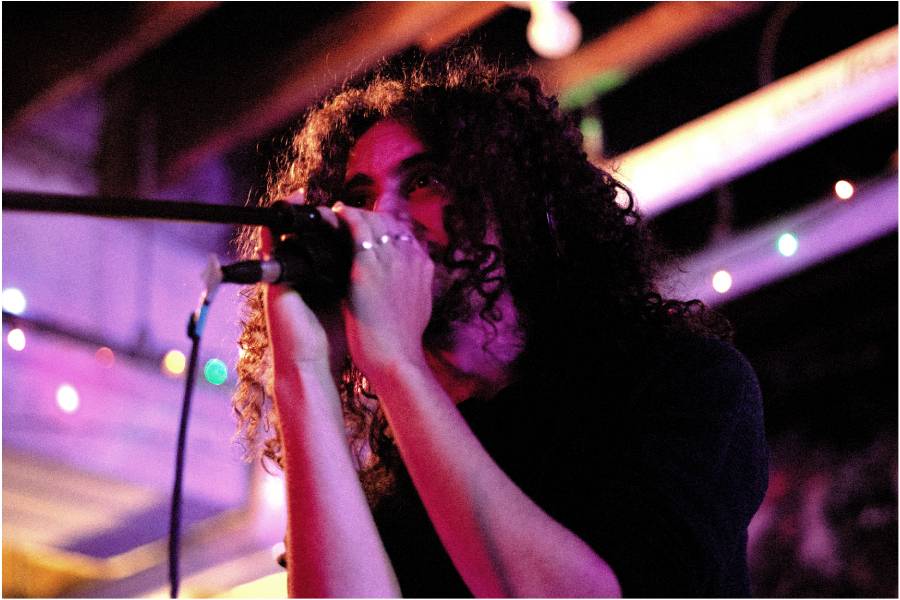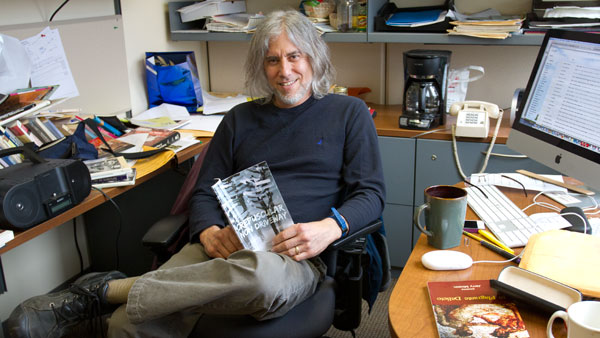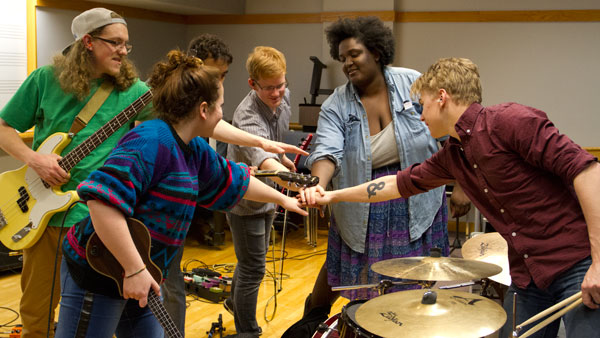Freekbass, a Cincinnati trio that performs hard funk influenced by mentor and producer Bootsy Collins, will play at 9 p.m. at The Haunt tonight to support their new live DVD, “A Sliver of Shiver.” Senior Writer William Earl spoke to bassist and lead singer Freekbass about audience energy, regional funk and the genius of Dr. Dre.
William Earl: What can people expect when they go to a Freekbass show?
Freekbass: Every night is definitely a little bit different. We focus on a collection of songs, but we do a lot of improvising on stage, so songs will have a different interpretation every night. It all depends on the groove and what kind of crowd is in the house. The ultimate show is when the audience becomes just as much of the show as the band — when the energy they are feeding is evident, they don’t necessarily need an instrument to be part of it.
In Ithaca, we had a really great show last time. It was cool because myself and Mike Gordon, who played bass in Phish, had been doing some stuff together. He used to play at The Haunt back when Phish was touring. He was on a road trip at the time and said he might come in and I thought, ‘I’ll believe it when I see it.’ Sure enough, he was there. The show was great and it was fun for us to reminisce.
WE: How do you bring the excitement of your live show into the recording studio?
F: It’s a big challenge to still have the energy and excitement of a live show in the studio, but they’re all different animals. When I first hooked up with Bootsy, I thought I was going to learn all of this great bass stuff, and of course I did. But the biggest thing is he really showed me how to record and write and do records in the studio — things like how to find the right mic placement. In terms of creating a good-sounding record, you have to focus on initial performance. If you pitch stuff in the studio, you are able to do stuff over and over again, and it is real tempting to rework and rework. But a lot of times you lose the flavor of the performance and it becomes too sterile-sounding. But when you make a little mistake in the studio, one that ultimately only you’re going to hear anyway, you want to leave those in.
One example of this is on our last album, “The Air is Fresher Underground,” the very first track is called “Knock the Walls Down.” The first thing I came up with was the bass line. I had a groove going with our drummer, and I had my old, beat-up bass and I was plucking away at three in the morning and I had a sloppy, funky bass line and then built the rest of the song around it. But when we set all of the amps up and had the sound be nice and pristine when we were ready to record, and no matter what I did, I couldn’t capture the vibe I had on that original take. If that sounded good, that’s the one we went with, and I’m so happy we did. That translates to live shows too, where you can only capture one live moment at a time.
WE: How do you create an image of Freekbass the artist, as opposed to someone who just collaborates with big name artists?
F: The people I have collaborated with, whether it is [keyboardist] Bernie [Worrell] or Bootsy or Buckethead, are people that have come from the same musical background as I have. It’s not like, ‘oh wow, let’s get this famous person on the record just because they are famous.’ It’s more stylistic choices and what matches together well. … The collaborations are great, but at the end of the day, the record is going to say Freekbass on it so you want to be able to capture your style.
WE: One of the high points of your shows is your soloing. Is it difficult to collaborate with artists such as Buckethead, a known shredder, where you have to back off?
F: I love all of the flashy stuff and going crazy on my bass, but as much as I like players like Bootsy or Flea [from the Red Hot Chili Peppers] or Les Claypool [from Primus] or people of that caliber, I’m just as fascinated by James Jamerson from the Motown era or Adam Clayton from U2 or early stuff from Sting in The Police. To me, the thing that brought me to the bass was that foundation. For example, if you see a drummer and all he can do is a bunch of drum fills, but he can’t play a straight beat, the fills don’t really mean much. The beat is what has fascinated me as much as getting crazy. Because of that, when I play with someone of that caliber [such as Buckethead], I have no problem being a traditional bass player. That’s what I love about the bass — you can always sit back and groove.
Even with someone like Buckethead — as much as he is a shredder, he’s more willing to lay back as well, and that’s what makes him special as a musician. The icing is all great on the cake, but if you put your fork in the icing and there is no cake, the icing doesn’t taste as good.
WE: Who would be a dream collaboration?
F: I’m a huge Dr. Dre fan. I would love to have Dr. Dre produce a Freekbass track. He’s been such a big influence not only as a producer but [for] all of the bass lines he uses. Stylistically, I love all of the darkness he uses — it’s dark but it’s groovy. He has a real good feel of the funk as well. If Dr. Dre reads this article, tell him to give me a shout on MySpace [laughs].
WE: Outside of Dr. Dre, does hip-hop and rap influence your work much?
F: Yeah. I love a lot of the grooves in that stuff. Hip-hop now soaks into so many styles of music and it has a feel like nothing else. Hip-hop comes from funk, and funk comes from R&B, and it’s all one big family of music anyway.
WE: How does your hometown of Cincinnati, Ohio affect your music?
F: I think that if I wasn’t born and raised in Cincinnati I would still be playing music, but I think the style of music, especially the funk influence, would not be there. Cincinnati is such a big funk region, which is funny because it is really conservative, but there has always been this really big funk thing. James Brown himself was from Augusta, Ga., but the label he was on, King Records, was set up in Cincinnati. All of his big hits were made in Cincinnati, and that’s how [Brown] discovered Bootsy [who was initially a player in Brown’s band]. Up the road, you had Zapp in Dayton, and the Ohio Players. In the ’80s, there was a band called Midnight Star. Every generation, there’s been this funk thing in Cincinnati, and no matter what part of town you grew up in, you always knew it and felt it.
Funk is neat too because every part of the country has its own unique interpretation of it. For instance, Cincinnati has that real heavy “on-the-one” kind of funk, as I call it, stemming back from James Brown’s thing. You go to New Orleans, and you get The Meters, who are more of a Creole-style sounding funk. And then you have more modern bands out of New Orleans like Galactic, who represent that side of funk. Then it goes to Oakland, Calif., and San Francisco, where you have that Sly and the Family Stone kind of funk and then the Red Hot Chili Peppers. It’s a very regional type of music.
WE: Can you tell me a bit about your customized bass?
F: [Laughs] More people know about that bass than me. I will go to shows and if I don’t play with it, people will ask where my bass is at. The symbol itself is a “one-two-three” up, with the neck being one and the body being two and then three. We used to use that symbol on posters and fliers as a logo, and then we had the idea of using it as a bass design. I was on the road down in Mississippi and I met this guy named Dwight Maddox and his company is named MDX Guitars. He said he would love to have a hand in helping to design that bass. The one you see me playing now is actually the second one he made for me. He’s actually making a third one for me too now. If you go to the extras section of my new DVD, you can actually see the whole “making of” the new one. He’s actually shopping a show in the same vein as “Monster Garage” — a guitar-making version of that show. They wanted to use the making of my bass into a pilot for the show, so you are seeing an early form of the show on my DVD. It goes all the way from him buying and carving the wood until its completion. One day I hope to have a whole wall of [those basses].
WE: How did you decide a DVD was the logical next step for Freekbass?
F: We’re finishing up our next studio album, and after we finished part of it we decided to take a break from touring and going all over the place. More and more, we were having people who couldn’t make the shows or people who were at the shows and wanted to get their hands on live performances. From there, we thought about having a live CD. But at one show, we were playing and Bootsy suggested we multitrack the show, and I thought that would be cool for the archives. … It wasn’t like we were setting out planning to do a DVD. … What you are seeing is just a show caught on tape and it is very spontaneous.
WE: After this tour, are you headed back to the studio to finish your album?
F: That’s exactly it. We have a few spotted dates this winter, but our focus now is the album. We have most of the record recorded, but we have some details and extras to attend to — putting all of the pieces together like a puzzle. Our touring schedule gets more hectic the warmer it gets. When festival season kicks in, we will be on top of that. So we’re going to have the record done for spring. As it gets cold and wintry, we will be in the studio like a bunch of trolls finishing it.
WE: Earlier in your career with [Cincinnati funk collective] SHAG, you opened for Kid Rock. Do you ever call him up and just kick it?
F: Originally, the reason we got together and played alongside and opened for each other was because Kid Rock’s manager was our manager’s lawyer. We played a lot of the same markets too because he was right up the road from us in Detroit. The last time I saw him was a few years ago and it was when his second major label album came out. He came to my studio when he was doing radio promotional drops for Cincinnati — that was when he was starting to take off big time. He’s one of the most down-to-earth people you can imagine and he works his rear-end off to get where he has gotten. It’s nice when you work with people who have had some success in the music business. Whether it is their talent level or work ethic, you can really see why they are where they are. It’s not just an accident. That’s encouraging for an up-and-coming musician, that it all pays off.
WE: Do you ever hope to achieve that same level of fame or do you enjoy more intimate crowds?
F: I don’t really think about it. I love touring and I love making records and as long as I am able to keep a roof over my head and a little food in my stomach, I’m happy. Whether I’m playing for 300 people or 3,000 people or 30,000 people, I’m just happy to be playing music. You get in such a bubble while you’re on the road. The level we’re at — we’ve had a crazy year where we would play at a club to 200 people and then go to a festival with 5,000 people and it changed from night to night. You have to have a level emotional base to deal with all that because being on the road is such an emotional roller coaster. And at the end of the day, the music is all that matters.
Freekbass is performing with The Rozatones and Monkmeat at 9 p.m. at The Haunt, 702 Willow Ave. Admission is $7 for 18+ and $5 for over 21.




